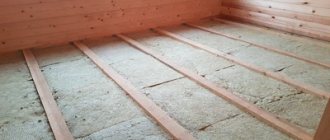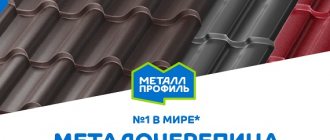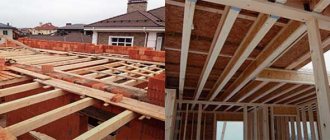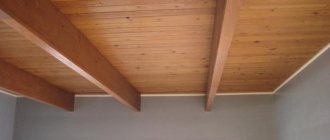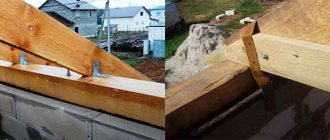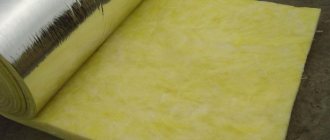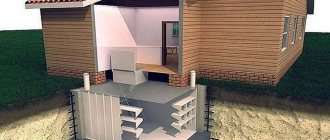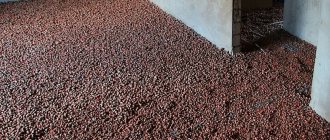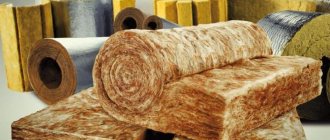If you are completing a house, almost the finishing work has already been done and you don’t know whether to take on the attic or whether this matter can wait, and in general what is needed at this stage - this article will help you. Here we will look at insulating attic floors with different types of materials, with step-by-step illustrations, expert advice and useful videos.
We will also reveal many important points about why insulation is so necessary and what an attic floor pie on wooden beams and on a reinforced concrete slab should actually be like - step by step.
Floor design
The basis of a wooden floor is beams that are supported on load-bearing walls and serve as a kind of “foundation” for the remaining structural elements
. Since the beams will bear the entire load during operation of the floor, special attention should be paid to their proper calculation
For beams, they usually use solid or laminated timber, logs, and sometimes boards (single or fastened in thickness with nails or staples). For floors, it is advisable to use beams made of coniferous trees (pine, larch), which are characterized by high bending strength. Hardwood beams perform much worse in bending and can deform under load.
Rough boards (OSB, plywood) are fixed to the floor beams on both sides, on top of which a facing covering is sewn. Sometimes the floor of the second floor is laid on logs, which are secured to beams.
It is worth remembering that the wooden floor on the side of the first floor will be the ceiling, and on the side of the second floor (attic, attic) will be the floor. Therefore, the upper part of the ceiling is sheathed with floor materials: tongue-and-groove boards, laminate, linoleum, carpet, etc. The lower part (ceiling) - clapboard, plasterboard, plastic panels, etc.
Thanks to the presence of beams, space is created between the rough boards. It is used to give the ceiling additional properties. Depending on the purpose of the second floor, heat-insulating or sound-proofing materials are laid between the floor beams, protected from moisture by waterproofing or vapor barrier.
In the event that the second floor is a non-residential attic that will not be heated, thermal insulation must be included in the ceiling structure. For example, basalt wool (Rockwool, Parock), glass wool (Isover, Ursa), polystyrene foam, etc. A vapor barrier film (glassine, polyethylene and polypropylene films) is placed under the thermal insulation layer (from the side of the first heated floor).
If EPS, which does not absorb water vapor, was used as thermal insulation, the vapor barrier film can be excluded from the “pie”. A layer of waterproofing film is laid on top of heat-insulating or sound-proofing materials that absorb and can deteriorate from moisture. If during finishing the possibility of atmospheric moisture entering the attic was excluded, the insulation does not need to be protected with waterproofing.
If the second floor is planned as a heated and living space, then the floor “pie” does not need additional thermal insulation. However, in order to reduce the impact of noise that will occur when people move along the floor, a soundproofing layer is laid between the beams (usually conventional thermal insulation materials are used).
For example, basalt wool (Rockwool, Parock), glass wool (Isover, Ursa), polystyrene foam, sound-absorbing ZIPS panels, soundproofing membranes (Tecsound), etc. When using materials that can absorb water vapor (basalt wool, glass wool), a vapor barrier film is laid between the first floor and the sound insulator, and waterproofing is placed on top of the sound insulator.
Advantages and disadvantages
The wooden blocks that are used for flooring have their strengths and weaknesses.
The main advantages of beams made from boards are:
- minimal weight of structural elements, which reduces the load on the load-bearing walls and foundation of the building;
- beautiful appearance;
- the possibility of installing a plank floor without additional preparation;
- high speed of installation work without the help of lifting mechanisms;
- It is possible to repair the ceiling during the operation of a residential building.
The disadvantages of wooden structural elements include:
- the need to impregnate wood with antiseptics and fire retardants; such solutions prevent rotting and combustion of the material;
- lower strength indicators compared to metal or reinforced concrete products;
- deformation and shrinkage of the structure as a result of sudden temperature changes or under the influence of high humidity.
Note! The installation of a wooden floor is possible on enclosing structures made of aerated concrete, brick or on walls made of any other material.
Basic requirements for floors
During the construction of floors, a sufficient degree of noise insulation should be ensured; the value is established by design standards. To do this, you should close the gaps at the places where the material joins; only in this case, sounds from neighboring rooms will spread minimally. Floors that separate rooms with a certain temperature difference must meet thermal protection requirements. This indicates the need to use an additional layer of thermal insulation. Any structure, especially one made of wood, is not able to withstand prolonged exposure to fire. It should be remembered that each material is characterized by a certain fire resistance limit. For reinforced concrete floors it is 60 minutes, but if the structure is made of wood with backfill and has a plastered surface underneath, then the fire resistance will last 45 minutes. Wooden floors that are protected with a layer of plaster can withstand flames for about 15 minutes. If there are wooden floors that were not protected with fireproof materials during the installation process, it should be taken into account that their fire resistance limit is even lower.
Determining the load on the attic floor
The attic floor must be strong enough to withstand the required load. The strength of the floor is influenced by several parameters that can be changed - the span, the cross-section of the beams, the pitch of their installation, the connections between the beams...
Let's take a closer look at how to select attic floor beams for a private house, the method of their calculation, and design options.
Factors determining the load on the floor
The load on the attic floor is created by:
the weight of the ceiling itself;
temporary operational load - people, loads that may be on the floor.
If only wooden parts and ordinary lightweight insulation are used to create an attic floor, then the specific gravity of the floor itself can be taken equal to 50 kg/m2. without detailed calculations.
If screed and partitions are additionally used, then their specific gravity must be increased. Typically, when using dry screed and lightweight hollow interior partitions, the specific load from the wooden floor and these structures is taken to be at least 100 kg/sq. m.
Determining the load on the attic floor
The temporary operating load may vary depending on the purpose and use of the attic space.
If the premises are not used at all, then the specific operating load according to SNiP is taken to be at least 100 kg/m2. (75 kg x 1.3 – safety factor). Then the total specific load on the attic floor will be 100 + 50 = 150 kg/m2.
For interfloor slabs, the temporary operational load, according to the standards, must be at least 200 kg/m2 (150 kg x 1.3). If an unheated attic is supposed to serve as a warehouse for unnecessary things, then it is equivalent to an interfloor ceiling. Total specific load – 250 kg/sq.m. (200+50).
If the attic floor is residential, and a floor screed (floating floor with sound insulation) and light sectional partitions, furniture, equipment, etc. are used, then, accordingly, the interfloor ceiling will have a total specific load of 300 kg/m2. (200 + 100 kg/sq.m.).
Determination of the section and installation pitch of beams
Previously, the initial data for the calculation were determined: – total specific load on the attic floor; – the size of the span between load-bearing walls;
You can use the tables for selecting beams for attic floors, which are given in SP 31-105-2002 “Design and construction of energy-efficient single-family residential buildings with a wooden frame”,
For an unused attic, the following section of floor beams and their installation pitch are proposed, depending on the size of the floor. But here the temporary operating load is assumed to be 35 kg/m2. - This is a very rare visit to the attic by only one person. This ensures that the beam deflects no more than 1/360 of the span length.
The following table is for interfloor slabs with a specific load of 240 kg/m2. The maximum deflection of the beam is also provided for no more than 1/360 kg/sq. m.
Installation of wooden floors between floors in a brick house
The installation of such an element in a brick house as an inter-beam floor should be carried out at the time of its construction. It is worth noting that the depth of the socket under the beam must be at least half the thickness of the material installed in the wall. It is not uncommon for beams to be installed through a cross-section, but such a structure must then be carefully insulated. Many people prefer to build a house themselves, even if it is made of brick.
To connect wooden floors to each other, special fasteners should be used
It is worth noting that you need:
Follow technology; Follow the instructions; Pay attention to the advice of experts.
It is necessary to calculate the support on the beams as clearly as possible in order to choose the optimal step between the beams
It is important to remember that beams are permissible for use as floors, including roof slabs, only if the house does not exceed 8 meters in length (beam support). Beams must be laid according to a certain principle
As a rule, they are installed on brick pillars, if we are talking about covering the first floor, and also on strong pillars made of thick timber, for the second.
In addition to many dangers, wood is the best option for building a house and forming floors, since it is environmentally friendly, completely safe and does not cause allergies or other reactions. Now it is very fashionable to build wooden houses, as they are warm, stylish, durable and, most importantly, not expensive.
Definition of section and pitch
After selecting the loads and determining the length of the beams, they begin to calculate the step of their laying for the installation of the formwork of the future floor, and also determine the size of their cross-section.
All work is carried out according to the following rules:
- the ratio of the width and height of the load-bearing elements of the floor is at the level of 1:1.4 (the width of the beam ranges from 4–20 cm, and the height of the products depends on the thickness of the heat-insulating material, and is in the range of 10–30 cm);
- the installation step of the beams is affected by the calculated loads and dimensions of insulation, plywood or any other material for filing;
- between adjacent beams leave a free space of 30 to 120 cm.
To accurately determine the cross-section of a wooden floor beam, there are special tables. When carrying out calculations, it is necessary to pay attention to the maximum deflection value; for attic floor beams no more than 1/200; for interfloor elements - 1/350.
Insulation with cotton wool
Comparison of mineral and ecowool. Click on photo to enlarge.
Today on the market you can find a variety of thermal insulation materials in the form of rolls or layers of cotton wool. This wool can be mineral, slag, basalt, etc. Among its attractive characteristics are the following:
- low thermal conductivity;
- excellent noise absorption;
- high level of fire safety;
- hygiene and environmental friendliness;
- resistance to mold, rot, destruction by insects and bacteria.
Today, not only floors, but also walls, roofing and slopes in window and door openings are insulated with cotton wool.
Features of thermal insulation
Interfloor wooden floors do not differ from each other in construction technology. But in terms of insulation, they differ somewhat from each other. Thermal insulation of residential and non-residential premises requires a special approach.
Attic
The attic itself comes in two types:
Cold .
This is a non-residential premises that is either completely empty or designated as a warehouse for equipment, old things, etc. In the first case, maximum requirements are set for the ceiling, the insulation layer is thicker, and vapor and waterproofing are required.That is, there should not be the slightest chance for a cold corridor to arise. The ceiling is insulated to the maximum, since the temperature in a cold attic in winter rarely exceeds 8 degrees.
- Warm .
This is a full-fledged room, an attic where people live, an office or a recreation room. If there is an attic, the requirements for floor insulation are the same as for a conventional interfloor. You can lay a small layer of sound insulation. Since there will be no strong temperature changes, the likelihood of condensation accumulation is also low, so a vapor barrier will not be required if the room is well ventilated. On the attic floor, walls and vaults are mainly insulated.
Basement and basement
The basement differs from the basement only in the level of ceiling above ground level. But even this is enough to make a difference between insulation methods. The basement is underground, the wind does not get into it, so the temperature there never drops below zero. However, laying vapor and waterproofing is necessary, because the moisture coming from the ground is enormous.
The basement floor is raised slightly above the ground, which means that cold can penetrate through small cracks between the brick, stone or wooden walls. The temperature there will be like in the attic, so it is necessary to insulate the basement floor more carefully, using high-quality, thick insulation.
Between floors
If the entire building has interfloor ceilings of the same type, wooden, and all rooms, upper and lower, are heated equally, then there is no need for a thick layer of insulation .
In this case, it is laid only as sound insulation. If the room is dry and warm, then there is no point in paying much attention to hydro- and vapor barriers. It is laid only to protect the insulation itself from rotting and moisture accumulation.
If there is high humidity in the room, for example, there is a bathroom on the lower floor and a bedroom on the upper floor, then high-quality waterproofing is needed. Firstly, there will be strong temperature changes in the bathroom, and secondly, moisture and hot air will rush upward, the insulation will accumulate moisture, the wooden beams will rot and everything that comes from it.
Installation of wooden floor beams
The technology for installing floors using beams involves performing work in several stages:
1. Calculation of the cross-section (diameter) of a wooden floor beam taking into account the requirements of SNiP 2.01.07-85 “Loads and impacts”.
Calculated indicator of the maximum permissible load per 1.m2. is:
- for basement and interfloor ceilings - no more than 210 kg;
- for the attic - no more than 105 kg.
In more detail, the section is calculated taking into account the distance between the beams (see the table of sections of floor beams).
Table of cross-sections of floor beams
When calculating the length of the beam, it is important to remember that wood is prone to bending
Calculation of the deflection of a wooden beam
for basement and interfloor ceilings, the minimum deflection cannot exceed 1/300 of its length. Those. beam 3,000 mm long. cannot bend more than 10 mm. in the place furthest from the support;
for the attic - no more than 1/200.
Deflection can be eliminated by bending the beam. Construction lifting, as this process is called, allows for compensation of deformations. Roughly speaking, the beam should be slightly curved inward in order to take into account the bending to take the proper shape.
2. Purchasing timber, logs or lumber and treating it with an antiseptic, fire-fighting, antifungal solution and biological protection.
3. Selecting the type of fastening of the beam to the wall.
Attaching wooden floor beams to a load-bearing wall is carried out in two ways:
wall mount. The beam is embedded into the load-bearing wall to a depth of 150-200 mm.
Fastening wooden floor beams to a load-bearing wall
With this installation method, the end of the beam must be cut at an angle of 60°. To protect the ends of the beam, they need to be wrapped in two or three layers of roofing felt. In this case, the end of the beam remains open, and it should not rest against the wall. There is a gap of 20-25 mm. will allow for free air exchange. And the resulting niche (gap) is filled with mineral wool.
hanging fastening. In this case, the beams are fixed to the wall using metal plates.
Fastening wooden floor beams using the hanging method
4. Laying wooden floor beams
At this stage, beams of the required length are prepared. The length depends on the installation method. If the beam is inserted into the wall, then it is calculated as follows: the length of the room plus 300-400 mm. for wall mounting. If attached to the wall, then the length of the beam is equal to the length of the room.
Installation of wooden floor beams begins with the outer beams. Each beam is checked with a building level. After this, the beams are fixed in the wall sockets using dry crushed stone.
Next, intermediate beams are installed. To do this, it is advisable to stretch the fishing line between the outer beams and set the rest along it. The distance between adjacent beams should be the same.
When the beams are installed exactly level and the horizontal position is checked, they can be concreted in the landing sockets.
Conclusion
Flooring with wooden beams made using this technology will reliably serve you for several decades. However, to extend its service life, it is necessary to treat the wood and carry out periodic inspections to monitor their condition. If there are defects, carry out repairs (partial or complete replacement of damaged elements).
Calculation procedure
A preliminary calculation helps determine the pitch of wooden floor beams, their sizes and quantity. Before carrying out such operations you must:
- carry out measurements of the span between the load-bearing walls of a residential building;
- calculate the load that the ceiling will experience after installation;
- carry out calculations of the section and pitch of beams using special tables.
The length of the base beams for the roof consists of the span size and the required margin of 10–15 cm for a reliable ceiling when supported on the wall. Span length is the distance between the internal parts of opposite walls in a residential building or any other building. The most popular option in private construction is considered to be a distance from 2.5 to 4 m. For spans greater than 6 m, wooden trusses are used to install the floor.
Important! The load on a wooden beam includes forces from the structures above, the internal filling of the floor, as well as temporary elements (people, household appliances and furniture).
Accurate calculations can only be performed by a construction organization specializing in this. For independent calculations, use the following values:
- the total standard load per square meter of flooring when using insulation (mineral wool) is 130 kg/m2;
- when using thick boards and heavy thermal insulation material, the standard load increases to 150 kg/m2, the total, taking into account the safety factor of 1.3 - up to 245 kg/m2;
- in the attic room, the ceiling is subject to temporary loads from the installation of furniture or the movement of people - the total load will be 350 kg/m2;
- the total load for interfloor spans is at least 400 kg/m2.
From a monolithic slab
Monolithic slab ceiling
This type of ceiling consists of a monolithic slab, which is manufactured on site and rests on the walls. Reinforcing mesh and concrete are used for manufacturing.
Monolithic slab flooring has a high surface quality and can be manufactured in any form of complexity.
Note! The disadvantage of making a monolith floor is the mandatory installation of formwork. If you choose the right covering option for your house and carry out all the installation and concrete work efficiently, you will get a durable and reliable covering
If you choose the right roofing option for your home and carry out all the installation and concrete work efficiently, you will get a durable and reliable floor.
See the video on the technology of pouring a ribbed monolithic floor below:
What parameters are needed and why?
Since two types of calculations are performed to design an attic floor: heat transfer resistance and strength, you will need to calculate the following indicators :
- The load-bearing capacity of the structure, this indicator completely depends on the building material of the structure and the type of floor: beam, beamless or monolithic.
- Vertical maximum deflection.
- Maximum moment Mmax and shear force Qmax.
- Dimensions of load-bearing beams or monolithic slab.
- The heat transfer resistance of each layer and the total for a multilayer ceiling
- The thickness of the thermal insulation.
- Vapor tightness.
Methods for laying basement floors
For a wooden plinth structure, a cranial block is required. It will allow you to insulate the floor. After all, it is on this that the panels or board covering the insulation are mounted.
The more popular option is a rough layer of rolled or unedged boards. The material is mounted on a wooden block with a square cross-section and a side of 5 or 4 cm. It is best to attach the cranial beam to the logs with self-tapping screws, but you can also use nails.
Advice! You can attach the board not to the skull block, but to a groove (quarter). It needs to be cut with chisels or power tools. It will take longer.
The subfloor of the basement is insulated with bulk materials, including sand. Antiseptic-impregnated sawdust or mineral wool 10 cm thick is often used. To protect wood structures, a waterproofing layer is laid underneath. The most practical option is bitumen roll materials. For rooms in contact with moisture, waterproofing is also installed on top.
Average cost of materials in the Russian Federation
The table shows average prices in the Russian Federation in rubles:
| Insulation | Release form | Volume, mass | Price | |
| Mineral wool | Basalt | Plates 12 pcs/pack. | 800x600x50 (1 piece) | 900-950 |
| Glass wool | Roll | 20 m2, 50 mm | 1100-1200 | |
| Ecowool | Package | 0.12 m3 | 100-110 | |
| Expanded polystyrene | Styrofoam | Plates | 100 mm | 300-320/m2 |
| EPPS | Plates in packaging | 13 pcs., 30 mm | 1400-1500 | |
| Polyurethane foam (spraying service) | Powder | Density 45-60 kg/m3 | 1200-1300/ m2 | |
| Foamed polyethylene (foil) | Roll | 5 mm, 1.2×25 m | 850 | |
| Wood sawdust | Shavings | car | 3500-5500 | |
| Fractional expanded clay | Fractions 10-20 mm | bag | 1800/m3 | |
| Foam glass | Plates | 1 m3 | 10100 | |
| Rice husk | Husk | ton | 1000 | |
| Metallurgical slag | Granules | ton | 600 | |
| Jute | Roller 20 m | 5-6 mm, | 130-190 | |
Wooden floor construction
The most common material used for installation of interfloor, roofing and floor coverings is wood. Especially in private buildings, since this material is easy to process, environmentally friendly, and easy and quick to install. Restrictions on the span length of wooden floors are eight meters. The main load-bearing elements are beams with cross-sectional dimensions of 5x15 cm (minimum) and 14x240 (maximum). Sometimes sanded logs of suitable diameters are used to make beams. The varieties of coniferous trees used for the ceiling are the most durable. Before installation, wooden structures must be thoroughly dried.
The quality of drying can be determined by tapping an ax on the products; the ringing and clear sound will confirm this.
The advantages of wooden floors include lightness, the ability to impart proper thermal and acoustic properties to the structure
Other structural elements are also used in floors to strengthen the beams, connect them firmly and create a reliable frame for the house. When constructing them, the following are used:
- Skull block is a 5x5cm wooden block, which, as a rule, is attached to the bottom of the beam, for hemming the ceilings below the located room.
- Subfloor boards. Even low-quality boards - unedged and unplaned - are suitable for the device.
- Floorboards are specially made, well-planed boards with tongue and groove.
- Insulation material - it can be ecowool, polystyrene foam (penoplex), rolled material for thermal insulation.
- Waterproofing and vapor barrier films that serve to prevent moisture from entering and remove condensation.
- Antiseptic impregnations, bitumen, paint, roofing felt.
- Decorative finishing materials.
Vapor barrier device in the interfloor ceiling
Some features of wooden floors
As mentioned above, the structure of the floors consists mainly of wooden elements, but the technology for finishing the floor and ceiling can use any modern material. Correctly installing various parts into a single floor structure is an important task; in this case, the beams will be reliable and will last a long time.
In particular, one of the important functions of floors is sound insulation. The advantage of wooden floors is that any insulating materials can be easily attached to them. The installation of decorative finishes is also good to give a modern design to the room.
Another difference between wooden floors is that they do not provide additional load. Therefore, by choosing wooden structures, it is possible to save on the construction of a reinforced foundation for the house. Proper installation of floors between the levels of the house allows the rooms to “breathe”, maintain the desired temperature and have good sound insulation. Wooden beams are very reliable and durable.
Proper installation of wooden floors between floors will eliminate noise and create a comfortable atmosphere in the house
The distance between the beams is calculated depending on the number of storeys of the building, its area and floor loads. Varies from 60 centimeters to 1 meter.
The length of the beams is selected taking into account their strong support on the walls of the building in special nests.
What insulation is suitable for the attic?
The attic floor needs to be insulated when the attic space is not planned to be used for housing. Those. we are talking about a cold attic, the roof slopes of which are not insulated at all. But not all the same materials are suitable for covering, so they are selected for slopes.
Mineral wool: no harmful dust
So, when insulating an attic floor with mineral wool, it is correct to use the so-called tension method. Its essence is that the insulating material is first laid - and so that it fits between the beams.
After this, three layers of slab or roll insulation made of mineral wool, with a total thickness of about 150 millimeters, are laid on it, and on top it is covered with a vapor barrier film. After this, it’s plywood, which should be no thinner than 18 millimeters.
Expanded polystyrene and polystyrene: ease of installation
The insulation of the attic floor using expanded polystyrene is also of high quality, the main advantage of which is that there is no need for vapor barrier, and all gaps are easily sealed with polyurethane foam.
Blown-in insulation: fashion and rationality
Recently, insulation of attic floors using the blow-in method has become especially popular.
The main advantage of blown-in insulation is that it automatically fills all the voids that exist and creates an even, continuous layer. In which there are no joints, no seams and no adjoining, and for which there is no need to cut separate small pieces of prickly insulation in order to plug something.
Today, to insulate cold attics in Russia, two types of blown-in insulation are mainly used: ecowool and blown-in wool.
Ecowool consists of up to 80% cellulose fibers, which are produced from ordinary waste paper, and 20% from additives such as Buran as a fire retardant and boric acid as an antiseptic. This insulation has high thermal conductivity.
But blown-in cotton wool is obtained by grinding ordinary mineral materials for thermal insulation, which for some reason did not pass product acceptance.
For example, they did not have sufficient density or correct fiber structure. And such material is crushed and packaged under high pressure, and therefore it is easy to transport it to the site, where everything will be loosened again upon arrival.
But still, ecowool is most often used as a material. The insulation process itself looks like this: one person must remain next to the installation and monitor its normal operation, while simultaneously loading the material. And the second person goes up to the attic with a hose, makes a cross-shaped cut on the vapor barrier (just between the beams), inserts the hose into this cut, and fills the cavity with material.
Plus, relatively inexpensive bulk materials are used to insulate a cold attic:
Types of wooden floors
Houses have a basement and attic space, and often have an attic. The type of overlap depends on this, for which different requirements are imposed in different cases.
There is the following division of load-bearing vaults by type:
- An interfloor ceiling that does not require good insulation, since it separates residential areas. The main requirement is good sound insulation.
- Attic, separating living quarters from the attic. Depending on whether the attic (attic) is heated or there is no heating in the room under the roof, the flooring is made of the necessary insulating material. But a vapor barrier layer is required to prevent the formation of condensation.
- Basement or basement, serving as the boundary between the basement. Here, thermal insulation comes first, cutting off the cold coming from below.
Attic floor made of I-beams
Depending on the requirements for the flooring, layers of insulation, vapor barrier or soundproofing materials of a certain thickness are added.
Wooden floor installation
Material selection criteria
The wooden frame of a private house has its own requirements for choosing a thermal insulation solution:
- coefficient of thermal conductivity. The indicator is important to ensure the required level of resistance to thermal energy losses;
- vapor permeability level. For example, to preserve the performance properties of mineral wool, protection with a vapor barrier membrane is necessary, since fibrous insulation absorbs moisture from the air;
- moisture resistance coefficient;
- flammability class;
- environmental friendliness;
- frost resistance;
- resistance to microbiological threats;
- level of attractiveness to rodents and insects;
- ease and convenience of installation.
Availability of material is also considered an important criterion. One of the most popular insulation materials in private housing construction is basalt wool. The solution provides extremely low thermal conductivity parameters, environmental friendliness, a high level of resistance to moisture and steam, is sold in a relatively affordable segment, and is suitable for self-installation.
Construction of interfloor vaults in a house made of aerated concrete
The main feature is that aerated concrete, despite all its positive properties, does not have sufficient strength. Because of this, it is not recommended to build buildings with more than two floors from ordinary aerated concrete.
Installation of wooden floors between floors
To install flooring between floors, especially when it is necessary to install the ceiling of the 2nd floor of a house made of aerated concrete, a reinforced support from a reinforced concrete belt located along the perimeter of the building or room is prepared in advance.
DIY work stages:
- The ends of the beams must be sawed at an angle of 60°-70°, creating an additional cavity for ventilation after installation.
- Next, the bars at the point of contact with the wall are wrapped with roofing material, which prevents abrasion of the structure stop. The end must be left open to remove moisture from the wood during ventilation.
- When creating niches for laying wood, it is necessary to calculate their size so that the gap between the wood and the wall above is at least 50 mm. After laying the beam, insulation, for example, mineral wool, is placed in this gap.
- Installation begins with the outer beams, mounting the ceiling along wooden beams. Then the intermediate slabs are installed, checking the correct installation according to the building level.
- The beam vault is fixed to the reinforced belt using metal corners, pins or special plates.
- The next step is the installation of boards and bars secured to the bottom of the beams.
- After fixing the bottom layer of the structure, the insulating layer is distributed, selecting its properties depending on the type of floor - providing thermal insulation, improving sound insulation or waterproofing.
Floor finishing on beams
Finally, logs are laid on top, on which the finished floor is mounted. The lower part of the vault is also refined, covered with clapboard, fiberboard, plywood or other finishing material.
Of all types of floors, those made of wood are more preferable when building a house on your own - wooden interfloor structures require less cost and are not very labor-intensive. Using timber, you can build any type of floor - interfloor, attic or basement (basement). You just need to correctly calculate the load and choose the right lumber for construction, which will ensure the strength and durability of the structure.
Glued laminated timber
To increase the strength or size of solid beams, they are fastened together manually during installation of the floors. For the same purposes, laminated veneer lumber manufactured at enterprises is used. It consists of several bars connected to each other. The thickness of an individual element is regulated by the number of products glued together. Glued laminated timber is produced at the factory by pressing, its length reaches 12 m.
Finished products retain the characteristics of solid lumber and can be nailed without loss of strength or cut into pieces of the required size. The only drawback of such structures is their high cost. It is necessary to carefully calculate everything before installing the first floor ceiling on wooden beams.
Note! Glued laminated timber is often used in construction for the installation of arched ceilings.
Calculation of the floor structure in a wooden house
It is on how correctly the expected load is calculated that you can create a high-quality, reliable structure that will perform its main functions and last for a very long time.
Most often, beams in a room are laid in the direction of the shortest wall. This makes it possible to keep the span to a minimum. The pitch between the beams will depend primarily on the size of the section. On average this size is 1 meter. Making the distance smaller is not worth it, as this will only increase the consumption of material and the complexity of the work.
Floor beam installation diagram.
It is better to give preference to beams with a large cross-section rather than making a floor with a small pitch and weak overlap.
The main dimensions of beams for a certain span size:
- 2200 mm span – section 75*100 mm;
- 3200 mm span – section 100*175 mm or 125*200 mm;
- 500 mm span – section 150*225 mm.
If the ceiling is made between the first floor and the attic, then the step between the material should be the same, but the cross-section of the beams can be chosen much smaller. This is due to the fact that the loads in the attic will be significantly less than on a full floor.
Necessary explanations for calculations
- Height and width determine the cross-sectional area and mechanical strength of the beam.
- Wood material: pine, spruce or larch - characterizes the strength of the beams, their resistance to deflection and fracture, and other special performance properties. Usually preference is given to pine beams. Larch products are used for rooms with a humid environment (baths, saunas, etc.), and spruce beams are used in the construction of inexpensive country houses.
- The type of wood affects the quality of the beams (as the grade increases, the quality deteriorates). 1st grade. On each one-meter section of timber, on any side there can be healthy knots measuring 1/4 of the width (face and edge), and 1/3 of the width (edge). There may also be rotten branches, but their number should not exceed half of the healthy ones. It should also be taken into account that the total dimensions of all knots in an area of 0.2 m must be less than the maximum width size. The latter applies to all grades when it comes to load-bearing beam structures. There may be plate cracks measuring 1/4 of the width (1/6 if they extend to the end). The length of through cracks is limited to 150 mm; first grade timber can have end cracks up to 1/4 of the width. The following wood defects are allowed: tilting of the fibers, tilt (no more than 1/5 of the side area of the beam), no more than 2 pockets, one-sided growth (no more than 1/30 in length or 1/10 in thickness or width). Grade 1 timber may be affected by fungus, but no more than 10% of the lumber area; rot is not allowed. There may be a shallow wormhole on the wane parts. To summarize the above: the appearance of such timber should not cause any suspicion.
- 2nd grade. Such a beam can have healthy knots measuring 1/3 of the width (face and edge), and 1/2 of the width (edge). For rotten knots, the requirements are the same as for grade 1. The material may have deep cracks up to 1/3 the length of the timber. The maximum length of through cracks should not exceed 200 mm; there may be cracks at the ends up to 1/3 of the width. Allowed: inclination of fibers, heel, 4 pockets per 1 m., sprouting (no more than 1/10 in length or 1/5 in thickness or width), cancer (extending up to 1/5 of the length, but not more than 1 m) . Wood can be affected by fungus, but not more than 20% of the area of the material. Rot is not allowed, but there can be up to two wormholes in a 1 m area. To summarize: grade 2 has borderline properties between 1 and 3, and generally leaves a positive impression upon visual inspection.
- 3rd grade. Here the tolerances for defects are greater: the timber can have knots measuring 1/2 the width. Face cracks can reach 1/2 the length of the lumber; end cracks measuring 1/2 the width are allowed. For grade 3, it is allowed to bend the fibers, tilt, pockets, core and double core, sprouting (no more than 1/10 in length or 1/4 in thickness or width), 1/3 of the length may be affected by cancer, fungus, but not rot are allowed. The maximum number of wormholes is 3 pcs. per meter To summarize: grade 3, even to the naked eye, does not stand out as the best quality. But this does not make it unsuitable for the manufacture of floors on beams. For more information about the varieties, read GOST 8486-86 Softwood lumber. Technical specifications;
Our online calculator will allow you to calculate the parameters of wooden beams and select the optimal floor configuration.
Technical requirements for floors
Interfloor structures consist of the following elements:
- beams;
- bars;
- layer of board;
- heat and sound insulation layer;
- waterproofing film;
- finishing board;
- ventilation slot;
- baseboards.
The following requirements are recommended for floor structures:
If the floors between which the floors are installed have a temperature difference of more than 10 degrees, then it is necessary to lay thermal insulation materials. Most often this happens between residential floors and the basement or attic. In such rooms it is impossible to do without a heat insulator. Regardless of the type of wood, the beams of the structure must have high strength. They need to withstand the load of the structure, the interior of the room and people. But in addition to this weight, there must be a certain reserve. It should be remembered that the minimum load on such floors is 210 kg/sq.m. m. For attics, the figure starts from 100 kg. The deflection value is applied to wooden structures. It should be less than 4 mm per meter. The indicator is calculated as follows: the length of the board is divided by 250 and the maximum deflection value is obtained. For the surface on which it is planned to lay tiles, the figure is divided not by 250, but by 400. For attics, the figure is divided by 200. The sound limit for materials should not be more than 50 decibels. This is worth considering when choosing sound insulation. Thermal insulators can significantly reduce noise
Sounds should not pass through ceilings and communications. When calculating floor materials, it is also important to take into account the length of wooden beams. It should not be more than 5 meters
For attics - 6. However, it is rare to find wooden structures more than 6 meters. If the area of the rooms exceeds 6 meters, supports are installed under the beams.
Note! Wood belongs to the class of highly flammable materials. In addition, it is susceptible to putrefaction, fungi and various bacteria.
Therefore, materials for floors must be processed before installation. The minimum set of impregnations consists of fire retardants and antiseptics.
The best and most sought after
If we talk about the most popular insulation on the market, then 2/3 of all houses are insulated using mineral wool , both for concrete floors and beams.
It is chosen for its moisture resistance, thickness, fire resistance and elasticity.
At the moment, this is the best option in terms of price and quality. It is easy to install and requires no further maintenance. It is used for both warm and cold attics.
However, foam, polystyrene insulation, although not as malleable in shape, does not require the use of a vapor barrier. They are not picky in installation because they do not crumble and do not get under the skin or into the respiratory tract. But they are more flammable, and this indicator reduces the scores for this material.
Natural insulation materials provide an advantage only from an environmental point of view; otherwise, they burn great and serve as a home for mice and parasites.
Granular insulation creates a truly warm atmosphere, but it is incredibly heavy and some types require the use of expensive equipment.
The best thermal insulators for warm and cold attics are those that are sprayed , filling all cavities, relief and cracks. They do not burn or ignite, do not require vapor or waterproofing, do not decompose over time and are not attractive to rodents and bacteria.
But since spraying work costs several times more than installing tile or matte insulation yourself, foam insulation is still left out.
How to protect the floor between floors
It is not enough to simply build a house correctly; it must also ensure that no problems arise during operation. To do this, even at the design stage, all factors contributing to its durability and protection of building structures are taken into account.
It is of no small importance to solve two problems - protection from fire and biological influence of the environment
Based on flammability, materials are divided into five categories, ranging from highly flammable to non-flammable. Structures made from various materials are distinguished by their ability to prevent the spread of fire. Fire-resistant properties - completely eliminating the spread of fire and semi-fire-resistant - capable of delaying its spread for some time. It should be noted that flammability is not the same as fire resistance. Fire resistance is understood as the ability of a structure or material to maintain load-bearing and enclosing functions in the event of a fire.
Protection from fire, fungus and insects
For these purposes, the wood is treated with fire-resistant solutions to ensure fire resistance for at least 30 minutes under experimental conditions. In residential construction, the structure of the second floor floor structure must have at least semi-fire-resistant properties.
When drawing up a design for floors, it should be borne in mind that beams are exposed to fire not only from the bottom side, but also from the sides.
The combustion rate of coniferous wood, according to resistance parameters, is 0.8 mm/min. Taking into account fire resistance, you should choose a material with a cross section of 11 by 24 cm, because with a beam height of 24 cm and a span width of 5.8 to 5.85 m, their width is increased to 120 mm or more.
The problem of protecting wooden structures from biological influences is also very relevant:
- water, which disrupts the structure of the tree and is a breeding ground for microorganisms.
- mold fungi, rot.
- insects that cause damage to the wood structure and rottenness.
- ultraviolet radiation, which contributes to the softening and darkening of wood.
Unlike other materials, wood is an environmentally friendly product, which is important for living spaces. In addition, wooden floors retain heat well in the house.
Now there is a tendency to return to natural materials that were previously used everywhere. Means have already been created to effectively protect wood from harmful influences that worsen its performance characteristics.
How to calculate?
Thermal engineering calculations of the attic floor must comply with the Russian regulatory framework for energy saving.
- SNiP 02/23/2003 - “Thermal protection of buildings”.
- SP 23-101-2004 - “Design of thermal protection of buildings.”
- GOST R 54851-2011 - “Heterogeneous building enclosing structures. Calculation of reduced heat transfer resistance."
- STO 00044807-001-2006 — Thermal insulation properties of building envelopes.
As a result of calculations, the compliance of the multilayer ceiling with sanitary and hygienic standards is checked.
Search for heat loss
For an example of calculating a 10×10 m attic floor located in Moscow, data for calculations is selected from climate reference books:
- Estimated temperature of internal air tb - +21 C;
- Number of days of the heating period Zot.per - 214 days;
- Average outside air temperature for the heated period tot.per - -3.1C.
They are used to calculate the degree/day of the GSOP heating period:
- GSOP = (tv - tot.per) • Zot.per = (21 - (-3.1)) • 214 = 5157.4 m2 • S/W
- Required heat transfer resistance: Rtr = a • GSOP + b = 0.00035 • 5157.4 + 1.4 = 3.2051 m2 •C/Wte
Based on the initial data, the thermal resistance of the multilayer floor is determined:
- The percentage of humidity in the attic ϕ is 55%.
- The coefficient of location of the outer surface to atmospheric air n - 1.
- K floor heat transfer (int) - 8.7.
- To the heat transfer of the wall surface α (ext) - 12.
- The standard temperature difference Δt (n) is 3C.
- Thermal resistance of the ceiling is 1.88 m2•C/W.
Next, the compliance of the multilayer ceiling with SES standards for thermal protection is checked. For this purpose, SNiP formulas are used.
Thermal resistance of the ceiling surface:
Heat transfer resistance of multilayer flooring:
Minimum required heat transfer resistance:
Vapor permeability resistance:
For example, for a multi-layer attic floor consisting of:
- Rough board - 30 mm.
- Vapor barrier membrane - 0.1 mm.
- Closed air gap - 20 mm.
- Pine and spruce lathing along the grain - 25 mm.
- Mineral (stone) wool 120-170 kg/m3 - 70 mm.
- Moisture-proof membrane - 0.1 mm.
- Chipboards, density 800 kg/m3 - 10 mm.
Thermal characteristics are taken according to standard tables and insulation thickness.
Based on the calculation formulas, the results of heat transfer resistance are obtained:
- floors [R], 2.08 m2 • C/W;
- according to SES standards [Rс] - 1.72;
- normalized [Re] - 3.16 m2 • C/W.
Since the actual heat transfer resistance exceeds the requirements of the SES R>Rc, the selected design provides thermal protection of the building, and the selected multilayer floor pie works without the formation of condensation in it.
Selecting material for interfloor slabs
There are 3 types of floors for houses of different heights:
- basement (basement, lower);
- attic (upper);
- interfloor.
Any of them consists of 2 structural elements: supports (beams) and sheathing (flooring). Depending on the purpose of wooden floors, different materials are used for their construction. Since they all consist of wood, installation work can be done with your own hands, without involving complex lifting equipment.
Wooden floors can only be built if the span between the structural elements of the building is no more than 8 m.
Beam selection criteria
The following materials are used as supporting elements:
- solid timber;
- knocked down boards;
- debarked logs.
The standard section of beams is 150/150 mm or 20/150 mm for timber, 140/240 or 5/20 mm for boards. You can use laminated veneer lumber. In terms of bending strength, it is not inferior to a solid one, and often exceeds it. Any material chosen for the installation of wooden floors must be well dried and free from defects in the form of cracks, knots and wormholes.
Logs are selected by tapping them with the butt of an axe. The tree should produce a clear and ringing sound. It is recommended to use coniferous wood, as they bend much better than hardwood. The length of the beams must be such that it is possible to place the support in the sockets in the walls intended for this purpose.
Requirements for wooden floors
- the structure must be durable and flawlessly withstand the expected loads;
- all floor elements in a wooden house must be designed for a service life that corresponds to the planned period of operation of the building;
- interfloor ceilings must provide for the presence of heat and sound insulation components.
Calculation of expected load
Before starting work, calculations are performed that help determine the required cross-section of beams, the pitch between them, and the amount of lumber. For this purpose, they either use special programs or focus on standard indicators. They are:
- For flights whose width does not exceed 2200 mm, beams with a section of 75x100 mm are used.
- For spans of 3200 mm - a section of 100x175 mm or 125x200 mm.
- For spans with a width of 500 mm - beams with a section of 50x225 mm.
The supports are laid in increments of at least 60 cm. If the beams are of a large cross-section, the distance between them is increased to 1 m. Installation of the floor begins from one of the short walls of the house. The beams (logs) should be laid perpendicular to the long walls.
Using boards and solid timber
In the case of using solid wooden beams or boards for flooring, the span length is chosen within 4–6 m, which is half the maximum distance when using building structures made of laminated veneer lumber. Parts made from bonded boards are often manufactured directly on the construction site.
The strength of the structure is superior to solid beams. The main advantage of the products is the possibility of constructing a composite part from several boards. Builders can independently regulate the thickness of the beam by fastening the required number of elements. The boards are connected to each other using threaded elements. Rubber or plastic washers are installed under the bolts and nuts. The elements prevent the effects of corrosion on metal embedded parts and protect the wood from cutting into the nut when tightening.
Insulation and finishing
The location of the horizontal partition in the cottage determines the use of insulating and finishing materials. The thickness of the floors between floors depends on the height of the beams, the number of layers and the characteristics of the finished flooring. Do-it-yourself reeling device diagram:
- 50x50 mm cranial bars are nailed to the bottom of the side surfaces of the beams. They will support the roll-up and the insulation layer;
- a roll is laid on the bars, which can be done by knocking down shields from boards;
- the shields are connected and attached to the cranial bars;
- if the ceiling is basement, then a vapor barrier film and insulation are laid on the “sub” floor. Waterproofing and a finished floor are laid on top;
- Interfloor floors are lined from below with a vapor barrier coating, then with ceiling boards, plywood or wood boards. After laying the heat and sound insulation, the structure is covered with a steam membrane and floorboards are laid.
Floor boards are impregnated with protective agents, painted or varnished. Linoleum, laminate, and parquet are laid on chipboards. The ceiling is leveled with decorative tiles, boards or plasterboard. Then the finishing coat is applied.
1. Wooden elements are treated with water-based products that are intended for indoor use. Senezh Ognebio, made in Russia, is suitable for this - complex impregnation belongs to the 1st group of effectiveness of protection against fire and the influence of biological factors on wood.
2. The ceiling opening should not exceed 6 m, and the step of laying load-bearing beams should not exceed 1 m.
3. The minimum distance between the support beams and exhaust ventilation shafts is 250 mm.
4. The minimum thickness of the thermal and sound insulation layer is 100 mm between living spaces and 200–250 mm for attic and basement systems.
Expanded clay with a fraction size of 5–10 mm, perlite, slag, dry sand, polystyrene foam or mineral wool are used as insulation. Bulk materials are more accessible, but make the structure heavier. The most acceptable option for a private home - mineral wool has low thermal conductivity, repels moisture and, unlike foam plastic, allows air to pass through.
Bugs and difficulties
The most common problems are:
- Sometimes manufacturers indicate the working side on vapor barrier rolls, sometimes not. How to determine which side to lay the vapor barrier on? On one side, it absorbs moisture, that is, it has small holes; if you run your hand over it, you can feel the roughness. It is this side that is absorbent; it must be laid “facing” the lower room. If the film is double-sided, then it should be laid as the roll unfolds.
- You only need to attach vapor barriers to each other, as well as to the walls, using special tape designed specifically for vapor barriers. No stapler or regular tape will provide the necessary sealing. If the sealing is not done well, condensation will begin to accumulate between the beams, which will cause them to rot, mold and complete destruction of the beams and the insulation itself.
- The width of the thermal insulation must clearly coincide with the pitch of the beams. You cannot place rolls or slabs of mineral wool with a gap or leave the remaining part in a raised state.
- The thickness of the insulation must correspond to the climatic conditions for a particular region. If the layer is smaller, freezing in a cold attic is possible on the outside of the insulation, especially mineral wool. All the frost in the form of water will penetrate into the cotton wool and go further to the ceiling of the lower floor.
- Rotting of insulation and wooden beams occurs mainly due to poor ventilation of the room. Therefore, the attic and basement must have a ventilation system connected to the street.
- Mineral wool tends to shrink over time. If 15 cm thick insulation is planned for the attic or basement, then it is better to lay 20 cm at once. In a year or two it will shrink to the required size. Manufacturers offer the highest quality material in the form of slabs; mats are softer and retain heat less well.
- The hydrobarrier cannot be replaced with ordinary polyethylene, as many private developers do. The waterproofing roll is designed in such a way that it can allow air to pass through, but cannot allow moisture to pass through. If you use ordinary film, there will not be proper ventilation between it and the insulation, moisture will begin to accumulate and the thermal insulation, along with the beams, will begin to rot.
- If yellow, damp spots begin to form on the ceiling, but the attic is dry and the roof is not leaking, then most likely moisture has accumulated in the insulation layer.
- Between the floors where the wiring is planned to be laid, it is better to wrap it separately in polyurethane foam so that it does not come into direct contact with the insulation and wooden elements. You should not rely on fire retardants and fire resistance of cotton wool.
Insulation of floors with slabs
https://youtube.com/watch?v=3wvmUOlkEwE
Insulation of the floors of basements, living rooms and attics is very often carried out by installing fire-resistant, rot-resistant slabs in the niches of the interfloor wooden floors. You can buy them, or you can make them yourself. You can independently determine the shape and area of such a slab in order to best fit it into the space between the beams. The density of such slabs reaches 500 kg/m3, that is, a slab with an area of 1 sq.m and a thickness of 1 cm weighs about 5 kg.
View of the interfloor floor prepared for insulation. Click on photo to enlarge.
Raw materials for slab insulation
The most common types of raw materials for insulation boards are foam concrete, slag concrete and sawdust concrete. Here are some recipes:
- sawdust, clay, sand, cement, water in the ratio 4:1:2:0.3:2.5;
- sawdust, lime paste, cement, water in a ratio of 1:1.5:0.5:2.
All components must be mixed well until a homogeneous mixture is obtained, and then poured into pre-prepared frame molds, the length, width and height of which are determined depending on the design of the floors in the house (the distance between the beams). The slabs are kept in a shaded and protected from moisture place until the mixture is completely dry.
The last requirement - the complete absence of moisture in the slabs - is mandatory, otherwise insulation along the interfloor beams will be ineffective. If moisture collects in the insulation already during the operation of the floors in the house, this also threatens the slabs with a complete loss of thermal insulation characteristics.
A recipe using roofing felt also shows good results. First, roofing material is spread over the beams, and a layer of sand-clay mixture is poured on top of it. When this composition is completely dry, it is covered with a layer of sawdust, wood shavings or slag. If in your region the temperature in winter does not drop below minus 20°C, then 14-16 cm of slag, 5-6 cm of sawdust, 7-8 cm of shavings is enough.
Next, a mixture of water, clay, cement and sawdust is prepared in proportions 4:4:0.3:1. Slabs are formed from this mixture, dried, and then laid on roofing felt. The joints between the slabs are filled with clay.
Remember that between the layer of thermal insulation and the finished floor it is necessary to maintain a distance sufficient to ensure free circulation of air and removal of vapors from the insulation. If the finishing floor covering is laid close to the thermal insulation layer, the wood of the floor may rot or become infected with fungi and mold over time.
The beams themselves and the cranial bars that are attached between them must be pre-treated with an antiseptic or a special wood primer to protect the wood from waterlogging and the same fungi.
If, upon completion of all floor insulation work, the temperature of the finished floor differs from the air temperature in the room by no more than 2°C, we can speak of effective thermal insulation.
How can you isolate?
To insulate floors, materials are selected that are most suitable for a particular climate and the structure of the floors.
When purchasing thermal insulation material, you should make the following requirements for it :
- lowest thermal conductivity;
- environmental friendliness (no toxic substances released);
- fire resistance;
- thickness appropriate to the climate;
- resistance to moisture accumulation;
- sufficient strength, resistance to shrinkage;
- ease of installation.
Insulation materials can also be divided according to their release form. There are both fairly dense options that you can walk on, as well as loose ones, such as sawdust or foam. The entire process of installing thermal insulation, including the structure of the ceiling itself (the pitch between the beams and the presence of sheathing), depends on the form of release.
The thickness of the insulation is of great importance; it is calculated using a certain formula:
q=R*k
Where:
- q – required material thickness;
- R – thermal resistance;
- k is the thermal conductivity of the insulation.
Table 1 shows the thermal resistance for each region:
Table 2 shows the thermal conductivity for each material:
For example , to calculate the required thickness of mineral wool for a wooden floor in Voronezh, you need 3.8*0.035=0.133. 13 cm is the required insulation thickness. But since the cotton wool will shrink over time, this figure can be rounded to 15-17 cm.
Minvata
For interfloor wooden floors, mineral wool and its varieties are most often chosen. This choice is due to the ease of installation, sufficient thickness, as well as excellent resistance to fire and smoldering. Basalt wool begins to melt only at a temperature of +600 degrees.
This is the highest figure among all known insulation materials. But it has a significant disadvantage - it easily accumulates moisture, as a result of which it becomes moldy. It is for this that the highest quality waterproofing is needed.
Polystyrene
There are 2 options for polystyrene:
- extruded;
- non-extruded.
They differ only in the degree of density. Non-extruded polystyrene is ordinary foam plastic, it is quite brittle and flammable material. Extruded polystyrene foam (EPS) is more durable and monolithic.
In terms of thermal conductivity and other indicators, they are almost the same. This insulation does not require water insulation; insects and bacteria are not interested in it.
Polyurethane foam
This type of insulation is considered the highest quality.
It has the required thermal conductivity, does not absorb moisture at all, does not shrink or decompose. Apply to any surface using a special sprayer .
As it dries, it swells, creating the desired thickness. It can be sprayed both on the floor and on the ceiling, insulating the ceiling on either side. During installation, polyurethane foam gets into all the cracks without creating gaps.
The only negative is that insulation services are quite expensive, so they are not yet so popular.
Wood sawdust
If there are no other options, you can insulate the ceiling with sawdust and shavings. The process is not simple, but it is cheap. To mix the composition, take cement, lime and water, mix and lay out a layer in the cells between the beams .
The insulation is heavy due to cement, and flammable due to sawdust. Therefore, the chips must also be treated with fire retardants. There are many disadvantages - mice love it, mold, it burns, it is afraid of moisture. One of the advantages is that it is cheap, you can buy a machine of sawdust for 3-5 thousand rubles and use it to insulate all floors from the basement to the attic.
Expanded clay
Expanded clay is produced in granules, similar in diameter to sand, crushed stone or gravel. These names are used for classification. For wooden flooring, coarse expanded clay is used. It is laid on a vapor barrier because it is able to absorb moisture because, in fact, it is fractional clay.
In terms of thermal conductivity, it is inferior to all of the listed insulation materials, and it is also quite heavy, because the insulation layer for it to work requires a large one, about 20 cm or more. It is quite popular on the market due to its low cost.
When to insulate the ceiling
According to the laws of physics, warm air always rises to the top. If the attic space is not heated, heat from the lower floor goes out through it. Heat loss can be up to 40%. Warm air escapes through small cracks in concrete and pores in wooden ceilings. Properly performed thermal insulation will prevent freezing and reduce heating costs.
In all private houses with a cold ceiling, it is recommended to thermally insulate the ceiling. Such work can be performed at the construction stage or in an already constructed house. In the second case, insulation is carried out if the coatings were made a long time ago and over time have lost their heat-insulating properties.
